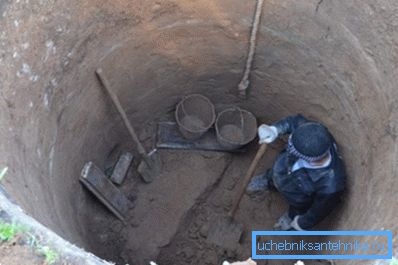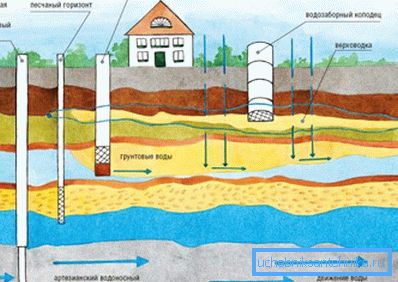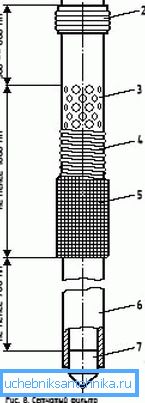Independent deepening of wells and with the help of
Own source of drinking water in a suburban area is the dream of every homeowner. However, it happens that the level in the well begins to decrease, and sometimes disappears altogether. If this is the usual silting, the solution can be simple and quick, and when geology comes into play, the deepening of wells with plastic pipes and other means of penetration to the water horizon can help.

Why increase the depth of the well
Usually it is advisable to resort the well deepening with your own hands or with the help of specialists in such cases when:
- there is no possibility to dig a new well;
- the depth of the source exceeded 10 rings;
- drying of the well;
- the source is filled per day in less than one ring.
In other cases, it is better not to use the methods of deepening the well, but to dig a new source.

Preparatory work
Water leaves the well for many reasons:
- the source was dug in a period of high water level;
- artesian wells, capable of diverting water, are closely located;
- drought that lasts a long time.
At the same time, it is necessary to make sure that the withdrawal of water is not related to temporary causes. When it is not there for quite a long time, the source should be deepened.
You can do it yourself or ask for help from professional teams, given that the deepening of the well on the quicksand is carried out only once.
The work of specialists begins with:
- water source condition assessments;
- checking the soil for its ability to hold rings;
- with clarifying the groundwater horizon and other factors affecting the performance of the deepening.
At the next stage, digging a well to the maximum possible depth of at least 3 m is performed. If the necessary calculations are not carried out, all efforts and monetary expenditures will be in vain. At the same time, it doesn’t matter who performed the work - whether you are on your own or professional teams.

Preliminary calculations make it possible to understand whether the source will provide the necessary inflow of water for a certain time. There are soils that do not allow the digging of the well on their own or the cost of further deepening is very high.
Increasing the depth of the water source in flowing soils
In this case it is necessary to take special measures during the work. It is necessary to immediately understand that it will not be possible to overcome the quicksand with the help of a bucket and a hand-held copra. For this, effective mechanisms are needed, there will be no result (read also the article Plastic well for the well - practical, convenient, beautiful).

The instruction prescribes that this section is overcome by accelerated penetration, using 3-4 repair rings and an additional section of rings, which is required to provide additional load.
Technology:
- the main and repair columns are scraped;
- Special equipment is used for penetration, which allows a large amount of soil to be lifted to the surface from the well at a time, significantly increasing the installation speed of the repair column.
The impact of the work can only hit repair columns in quicksand with solid rock. Although this situation happens very rarely, but there is such a possibility.
In this case, the penetration should be stopped, put a shield of hardwood on the bottom and pour off the filter. As a result, you will have a much more powerful water flow than it was before the repair.
Tip: use this technology and when deepening the well yourself when passing clay quicksands.
Filter recess
There is another resuscitation method for the well that can be effective in some cases.
Call it - deepening using a filter or deepening the well with plastic pipes.
- prepare a plastic pipe (can be replaced with a metal one) O 50 cm and 1 m long;
- make a perforation in it and tie a fine-meshed mesh, preferably stainless steel;
- dig a hole in the pit at the bottom of the well and set this filter down as the depth increases.
An independent process of deepening the well with a plastic pipe is laborious and dangerous. If you do not have enough experience, it will be extremely difficult to get the desired result. Experts can determine the ability of the reservoir to water content on various grounds, which, alas, not every homeowner can not do.

When you decide to carry out repairs and increase the depth yourself, carefully study all their stages.
- Diagnose the condition of the source and prepare it for stocking installation.
- Determine the materials, make an estimate, also carried out cleaning and preliminary preparation of the well.
- Deliver the material to the work site, make a stocking and clean the well again.
- The filter may be fine fraction gravel, coarse sand or sand concrete. And it is better to entrust the choice to a qualified specialist.
- Remove water lifting or other equipment before starting work.
Tip: for zabutovki wells made in clay soil, zabutovki use well-permeable material.
Plastic wells are connected to the pipeline using a threaded connection or welding. Today, monolithic wells that have proven themselves in places with constant exposure to sewage are particularly popular among consumers.
One of the advantages of this method of well deepening is the ease of transportation and installation. If a huge trench is required for concrete rings, in this case the diameter will not exceed 300 mm. There is no need to carry out concrete work, and the connection of the well to the main pipe takes place in a few minutes, moreover, there is no need to take care of waterproofing.
Conclusion
Different ways to increase the depth of the source, such as the deepening of wells in the quicksand, using concrete rings or plastic pipes allow you to reanimate it and achieve an increase in water flow (see also Decorative wells made of wood - decoration of your site).
In the presented video in this article you will find additional information on this topic.